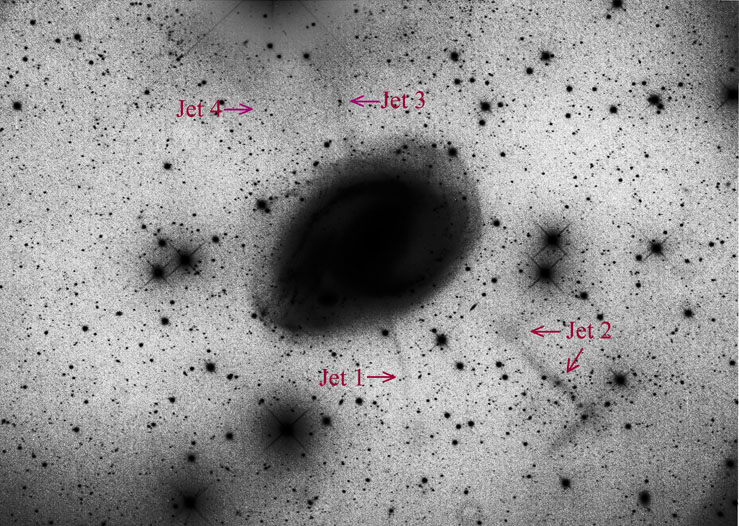
NGC 1097 is a bright barred seyfert galaxy with an active nucleus (AGN). It is known to have the longest optical jets of any known galaxy. Other galaxies possessing optical jets include M87 and NGC 5128. The jets of NGC 1097 have very low surface brightness and are visible only in deep exposures using aggressive data manipulation. The jets were intially discovered by Halton Arp in 1975 and their nature has remained somewhat controversial. The four jets seem to point away from the galaxy forming an "X" which traced backward intersect at the nucleus of the galaxy. Jet 2, the brightest jet, shows a peculiar "dogleg", a narrow filament that ends with a right-angle turning into a tangential arc. This feature is peculiar but not unique (see NGC4651) and can be seen in tidal plumes of ejected stars.
Since the four jets appear to radiate from NGC 1097's active nucleus, it was natural that early interpretations invoked an "ejection" phenomenon related to its active galactic nucleus similar to M87's jet. Two papers ( Wherle, et. al. 1997, AJ) (Higdon, et all. 2003, AJ) investigated the nature of the jets and came to new conclusions based on X-ray and radiowave data: 1) the jets have little neutral hydrogen 2) the colors are very blue, consistent with starlight 3) morphologically, the jets are different than the jets of M87 and not likely due to an "ejection" phenomenon. It was proposed that the jets of NGC 1097 are likely the result of an ancient merger event in the history of NGC 1097 in which a dwarf companion galaxy was cannabalized and incorporated into it's disk. The apparent “X” pattern of these jets is highly consistent with computer simulations of such an event.
To add to the mystery of NGC 1097 and its optical jets, X-ray and radio images of NGC 1097 show lobes of emission and several bright focal sources in line with the jets. Many of these focal sources are known to represent Quasars. According to traditional theory Quasars are extremely distant objects but intriguingly their numbers increase toward the galaxy and they seem to be aligned with the jets. For distant objects that have no connection to the galaxy, this remains unexplained.
